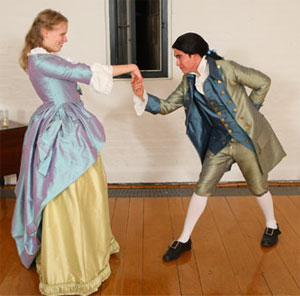 |
| Elise Sinclair and John Renaud portray Margaret and Joseph Scott, who lived in Scott Manor House in present-day Bedford. (Nick Pearce Photo) |
Wearing dresses that ballooned off their hips and nipped in their waists, the students walked sideways through the small arched doors between rooms in the Halifax Citadel and onto an 18th century “catwalk.”
“I couldn’t help it,” says Jessica Power, one of the students who took part in the showcase, Halifax: The Early Years. “I kept bumping into people when I went down the aisle.”
It was part fashion show, part history lesson as third-year students in costume studies modeled clothing that some of Halifax’s well-heeled early settlers would have worn. The casemates at the Halifax Citadel National Historic Park furnished the perfect setting for the end-of-year showcase on Friday, April 17.
SEE MORE PHOTOS: Halifax historical dress
The show capped off a full year of research for the students, who investigated the lives and times of historical figures and then recreated the clothes they would have worn, based on paintings and portraits from the period. Each student created two complete outfits from the underwear on out, a three-piece suit for a man and a gown for a woman.
Menswear included a country coat, waist coat and breeches. A man‚Äôs shirt also served as his underwear and nightshirt. Depending of his social status,¬Ýthe shirt¬Ýwould have been adorned with ruffles, lace and embroidery. It was cut from rectangles and squares, with as little waste of fabric as possible.
“It feels so great to wear this,” says Mark Neufeld, an acting student who wore a long dark jacket with wide cuffs and fawn-colored waistcoat made by Johanna Tower. “It fits me exactly. It is so perfectly tailored. You can’t help but stand more upright when you’re wearing clothes like these.”
Women wore a shift next to their bodies, usually long and sewn from fine linen. On top of the shift, they wore stays, boned with narrow strips of baleen which came from the roof of the mouth of the whale. The whalebone was also used in pocket hoops, basket-like frameworks worn on the hips and underneath skirts.
The women of the time (1749-1760) didn't wear knickers of any kind, reminds Prof. Dianne Kristoff, so chemises and petticoats were long to give them warmth.
Over top of their voluminous underclothes, the women wore richly embellished gowns made of silk: the 18th century silhouette favored a conical bodice and a wide, boxy skirt.
“The tough part was all this fabric and trying to control it all when it seemed like it would get out of hand,” says Jessica Power, who wore a gown of sage-green silk and was accompanied for the evening by her father Maurice Power.
